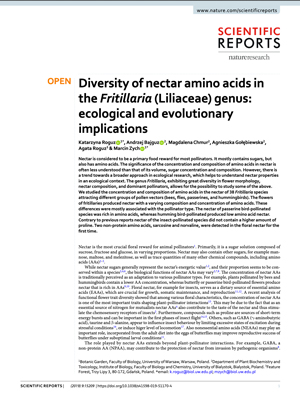NEWS 2019
Diversity of nectar amino acids in the Fritillaria (Liliaceae) genus: ecological and evolutionary implications
Katarzyna ROGUZ1, Andrzej BAJGUZ2, Magdalena CHMUR2, Agnieszka GOŁĘBIEWSKA2, Agata ROGUZ3, Marcin ZYCH1
Scientific Reports volume 9, Article number: 15209 (2019)
https://doi.org/10.1038/s41598-019-51170-4
1Botanic Garden, Faculty of Biology, University of Warsaw, Warsaw, Poland
2Department of Plant Biochemistry and Toxicology, Institute of Biology, Faculty of Biology and Chemistry, University of Bialystok, Bialystok, Poland
3Feature Forest, Trzy Lipy 3, 80-172, Gdańsk, Poland.
Abstract
Nectar is considered to be a primary food reward for most pollinators. It mostly contains sugars, but also has amino acids. The significance of the concentration and composition of amino acids in nectar is often less understood than that of its volume, sugar concentration and composition. However, there is a trend towards a broader approach in ecological research, which helps to understand nectar properties in an ecological context. The genus Fritillaria, exhibiting great diversity in flower morphology, nectar composition, and dominant pollinators, allows for the possibility to study some of the above. We studied the concentration and composition of amino acids in the nectar of 38 Fritillaria species attracting different groups of pollen vectors (bees, flies, passerines, and hummingbirds). The flowers of fritillaries produced nectar with a varying composition and concentration of amino acids. These differences were mostly associated with the pollinator type. The nectar of passerine bird-pollinated species was rich in amino acids, whereas humming bird-pollinated produced low amino acid nectar. Contrary to previous reports nectar of the insect-pollinated species did not contain a higher amount of proline. Two non-protein amino acids, sarcosine and norvaline, were detected in the floral nectar for the first time.




